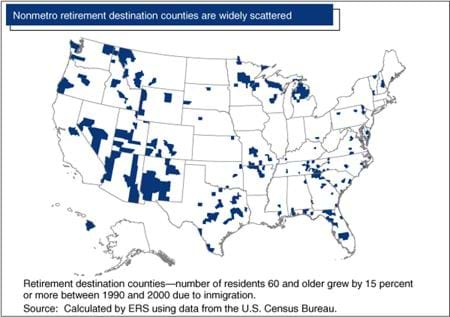Rural America as a Retirement Destination

Most Americans do not move to a new community when they retire, but of those who do, many settle in a rural area or small town. During the 1990s, a half million more persons who were age 60 or older in 2000 moved into nonmetropolitan (nonmetro) counties than out of them. However, not all nonmetro counties are as attractive to retirees as others.
In cooperation with the University of Wisconsin-Madison, ERS has identified 277 nonmetro retirement destination counties (13.5 percent of all nonmetro counties) where the population age 60 and older grew by 15 percent or more in the 1990s through net inmigration. In contrast, only 36 nonmetro counties qualified as retirement areas during 1950-60, when data were first available.
Today’s retirement areas are widely scattered across rural America. Warm winter areas have their appeal, but so, too, do many counties in the cold winter climate of the Upper Great Lakes, or the uplands of the Ozarks and the southern Blue Ridge Mountains, especially around dam reservoirs. Other destinations are the Texas Hill Country, both the Atlantic and Pacific coasts, and many parts of the inland Mountain West from Montana to New Mexico. With an estimated net inmovement of 17,900 older people from 1990-2000, Mohave, AZ, had the highest increase of all counties. Sussex, DE, and Citrus and Sumter Counties, FL, also had retiree inmovement of 10,000 or more each. The most rapid relative increases by far took place in Sumter, FL, and Nye, NV, where the population age 60 and older rose by 125 percent through inmovement. Fourteen other counties had increases of more than 50 percent.
Although retirement counties are defined only by the growth of their older population, they also tend to have high overall population growth. From 2000 to 2003, their total population grew by 4.8 percent, three times as fast as total U.S. nonmetro population growth and faster than any other type of nonmetro county.
The high net movement of older people to 277 nonmetro counties came despite the fact that persons reaching age 60 during the 1990s were the survivors of the low birth rate years of the 1930s. Today, in contrast, members of the much larger birth cohorts of the 1940s are now entering their sixties. Thus, the prospect is for greater retiree movement to rural and small-town locales and an increase in the number of counties that can fairly be termed retirement counties.
County Typology Codes, by John Pender, USDA, Economic Research Service, October 2019


